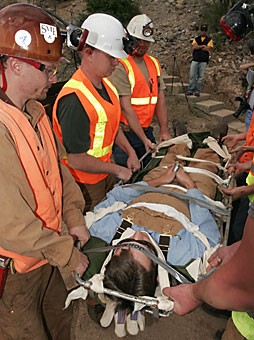Carrying the limp body of John Featherston in a Stokes Litter rescue basket, 10 UA students emerged from the San Xavier Mining Laboratory’s mine Saturday to deliver the man to the Helmet Peak Fire Department for medical treatment and helicopter evacuation.
Featherston, a mining engineering senior and mining manager at the laboratory, claimed to have suffered leg and head injuries from a fall inside the mine.
However, the disaster was part of a scenario the students established as a rescue exercise.
Though he had received no real injuries, Featherston acted as the dummy in the mine rescue simulation designed to teach students in a UA mine health and safety class the proper procedure for securing an injured miner to a Stokes Litter rescue basket, giving First Responder aid and delivering him to paramedics.
“”It is truly hands-on for the students,”” said John Ros Hill, an adjunct professor for mining and geological engineering.
Hill, who teaches the mine health and safety class, said he uses the UA-owned San Xavier Mining Laboratory to show students how to use equipment, do environmental monitoring and practice safety, which he considers the most important part of working underground.
The students began the exercise by establishing the scenario in which Featherston would be injured, practicing the procedure of securing someone to a Stokes Litter rescue basket and learning about things to watch for in a real rescue situation that may not occur during the simulation.
“”They usually don’t say a word, you just hear thud, thud, or&133thunk,”” said John Stanford, a state deputy mine inspector.
There have been 11 mine-related deaths in Arizona since 2000, according to the State Mine Inspector’s Office.
Hill said he does not disagree that the job can be dangerous, which is why exercises like Saturday’s are invaluable for the students.
The students were not the only group to benefit from the exercise, as the Helmet Peak Fire Department and the Arizona Lifeline Air Medical Service crews treated it like a real emergency.
“”This is pretty close to real, except not everyone is running around like chickens with their heads cut off,”” said Alan Heimback, a fireman with HPFD.
After the students exited the mine with Featherston secured to the rescue basket, an ambulance from HPFD arrived and the students handed their classmate over to the paramedics who rushed to check his pulse and responsiveness.
Featherston was then placed on a gurney and loaded into an ambulance to be driven to the makeshift helicopter landing surface, which the HFDP wet down to avoid “”brown out,”” a cloud of dust and debris that the wind from the helicopter could pick up.
The firemen and paramedics attempted to load Featherston into the helicopter, but the mine’s rescue basket did not fit, forcing the crew to move Featherston to another gurney.
After moving John Featherston, the crew flew toward Carondelet St. Mary’s Hospital, an eight-minute flight from the mine, said Greg Featherston, an Arizona Lifeline pilot and relative of John Featherston.
Brendan Sullivan, a mining engineering junior whose father and grandfather worked in mines, said the exercise was successful and accurate.
“”It was a practical application of stuff we’ve been taught in the classroom,”” Sullivan said.
Once the helicopter had made the trip to and from the hospital, John Featherston said he was relieved to be released from the rescue basket that he was fastened to for an hour and a half.
“”It was a little bit emotional at times,”” Featherston said. “”I thought, ‘My god, if this was real…'””









